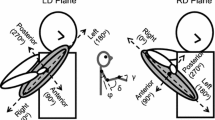Abstract
The aim of our investigation is to understand the mechanisms which control the movement of the human arm. The arm is here considered as a redundant system: the shoulder, elbow and wrist joints, which provide three degrees of freedom, combine to move the hand in a horizontal plane, i.e. a two dimensional space. Thus the system has one extra degree of freedom. Earlier investigations of the static situation led to the hypothesis that independent cost functions were attached to each of the three joints and that the configuration chosen for a given target position is that which provides the minimum total cost (Cruse 1986). The aim of the current investigation was to look for measurable values corresponding to the hypothetical cost functions. Experiments using pointers of different lengths attached to the hand showed that the strategy in choosing the joint angles are independent of the limb length. The muscle force necessary to reach a given angle is increased by a spring mounted across a joint. In this situation the angles of the loaded joint are changed for a given target point to give way to the force effect. This leads to the conclusion that the hypothetical cost functions are not independent of the physiological costs necessary to hold the joint at a given angle. The cost functions seem to depend on joint angle and on the force which is necessary to hold the joint in a given position. Cost functions are measured by psychophysical methods. The results showU-shaped curves which can be approximated by parabolas. The position of minimum cost (maximum comfort) for one joint showed no or weak dependency on the angles of the other joints. For each subject these “psychophysical” cost functions are compared with the hypothetical cost functions. The comparison showed reasonable agreement. This supports the assumption that the psychophysically measured “comfort functions” provide a measure for the hypothetical cost functions postulated to explain the targeting movements. Targeting experiments using a four joint arm which has two extra degrees of freedom showed a much larger scatter compared to the three joint arm. Nevertheless, the results still conform to the hypothesis that also in this case the minimum cost principle is applied to solve the redundancy problem. As the cost function for the whole arm shows a large minimum valley, quite a large range of arm positions is possible of about equal total costs. The scatter does not result from pure randomness but seems to be mainly produced by the fact that the angles at the end of the movement depend on the value of the joint angles at the beginning of the movement.
Similar content being viewed by others
References
Cruse H (1986) Constraints for joint angle control of the human arm. Biol Cybern 54:125–132
Cruse H (1989) The control of path and joint angles in a human arm. In: Personnaz L, Dreyfus G (eds) Neural networks from models to applications. IDSET, Paris, pp 71–77
Cruse H, Brüwer M (1987) The human arm as a redundant manipulator: the control of path and joint angles. Biol Cybern 57:137–144
Soechting JF (1982) Does position sense at the elbow reflect a sense of elbow joint angle or one of limb orientation? Brain Res 248:392–395
Soechting JF, Ross B (1984) Psychophysical determination of coordinate representation of human arm orientation. Neuroscience 13:595–604
Stevens SS (1958) Problems and methods of psychophysics. Psychol Bull 55:177–196
Weiss PL, Kearney RE, Hunter IW (1986) Position dependence of ankle joint dynamics. I. Passive mechanics. J Biomech 19:727–735
Author information
Authors and Affiliations
Rights and permissions
About this article
Cite this article
Cruse, H., Wischmeyer, E., Brüwer, M. et al. On the cost functions for the control of the human arm movement. Biol. Cybern. 62, 519–528 (1990). https://doi.org/10.1007/BF00205114
Received:
Accepted:
Issue Date:
DOI: https://doi.org/10.1007/BF00205114




